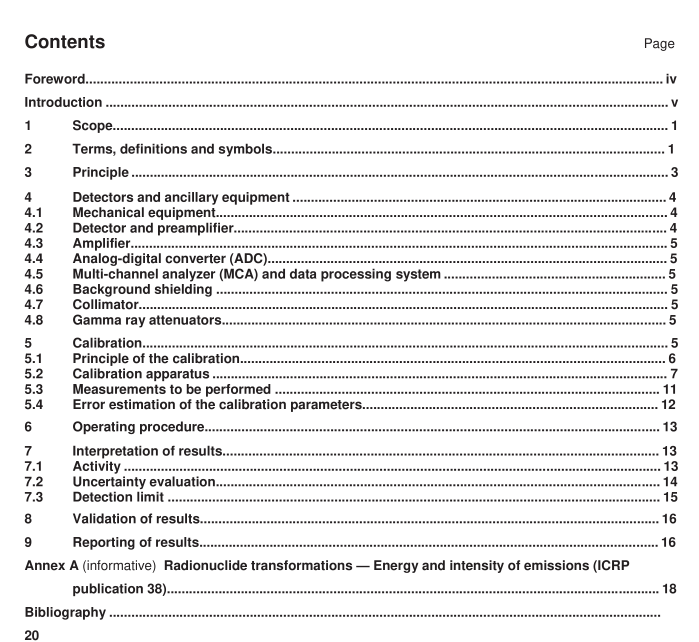BS ISO 14850-1 pdf download

BS ISO 14850-1 pdf download Nuclear energy — Waste-packages activity measurement — Part 1: High-resolution gamma spectrometry in integral mode with open geometry
1 Scope
This part of lSO 14850 describes a procedure for measurements of gamma-emitting radionuclide activity inthe following homogeneous objects:
unconditioned waste, including process waste (filters, control rods, etc.), dismantling waste, etc.;
waste conditioned in various matrices (bitumen, hydraulic binder, thermosetting resins, etc.), notably inthe form of 100 l, 200 I, 400 l or 800 l drums, and test specimens or samples, (vitrified waste);
waste packaged in a container, notably technological waste.
lt also specifies the calibration of the gamma spectrometry chain.The gamma energies used generally range from 0,05 MeV to 3 MeV.2Terms, definitions and symbols
For the purposes of this document, the following terms and definitions apply.
2.1
reference source
radionuclide sealed in a suitable containment, of which the radioactive characteristics are determined bycomparison with a reference material
2.2
source volume
volume in m3taken up by the matrix (or by the waste) in which the activity is distributed
2.3
source weight
weight in kg of the matrix in which the activity is distributed2.4
package
object to be characterized, comprising an outer shell (container or canister) surrounding the (conditioned orunconditioned) source volume
2.5
mockup
package consisting of a container and of well-known materials representative of a matrix
2.6
reference package
mockup containing reference sources in a well-known configuration
2.7
apparent density of the source
ratio of the mass of the source to its volume
2.8
container
envelope of source volume
2.9
matrix
structural material immobilizing the radioactivity
2.10
radioprotection-shield
material of suitable nature and thickness placed around a package to attenuate the photon emission flux
2.11
gamma ray attenuator
material of suitable nature and thickness placed between the package and detector to attenuate the photon
flux
2.12
detector
any type of high-purity germanium semiconductor
2.13
efficiency
ε
ratio between the number of detected events and the number of emitted gamma photons
2.14
collimator and background shield
protective devices for the detector to decrease background by limitation of the solid angle and gamma background (collimator) and reduction of the ambient background incident (background shielding)
2.15
background noise
B e
number of counts in s − 1 recorded at energy e in the background spectrum in the absence of any source,sample or package
2.16
decision threshold
T D
value (in s − 1 ) above which an observed quantity is considered true, within the risk α NOTE This limit corresponds the risk α of affirming the presence of the true quantity when it is in fact not present. The recommended value of α is 2,5 %
2.17
detection limit
2.20
expanded uncertainty
product of the standard deviation by the coverage factor, k
3 Principle
This part of ISO 1 4850 describes a non-destructive method implemented using fixed or mobile equipment,which is based on measuring the photon emission rate at different energies by gamma spectrometry:
to identify detectable radionuclides in the objects in Clause 1, either by direct measurement or by using decay schemes;
to determine the activity of the identified radionuclides from the counting rates recorded under each total absorption peak, weighted by a calibration factor.
The method implies optimization of the equipment parameters, energy calibration and efficiency calibration (by modelling the transfer function or by fabricating mockups):
choice of detector(s), electronic circuitry and shielding;
choice of measurement geometry;
choice of calibration geometry.
The method may be validated:
by comparison with destructive examination results on representative samples;









